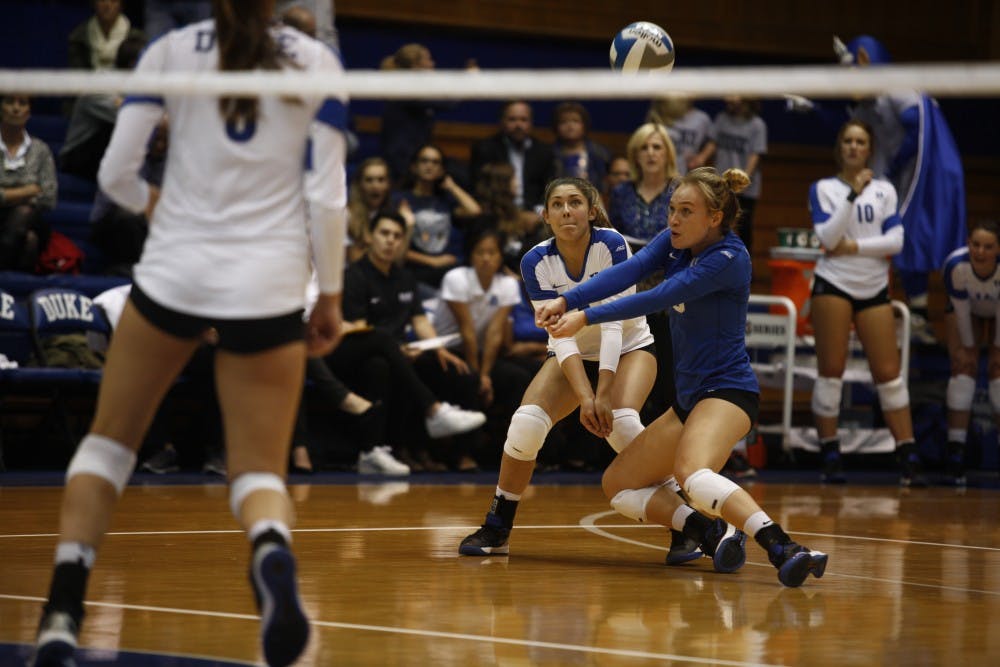With new hydration formulas, shirt technologies and workout regimens, it seems like athletes are doing whatever they can to get ahead in their respective sports. For several Blue Devils, the next training tool just might be beach volleyball.
The appeals of beach volleyball are many—Duke players have turned to competing with a partner in the sand as a means of improving shot accuracy, reading defenses and rounding out their skills. So while senior Emily Sklar played against top international talent at the World University Games this summer, Sasha Karelov, Cadie Bates, Christina Vucich and Nicole Elattrache battled on the beaches of southern California.
“I am a huge supporter of them playing sand volleyball,” head coach Jolene Nagel said. “It’s two-on-two, in the sand, so it’s hard and great conditioning, but it’s also easier on the body than a hard court.”
With two players inside the lines rather than six, each competitor covers more territory, even though the beach surface is smaller than the indoor one. The result is an emphasis on analyzing the opponent, anticipating the shot and diving for anything within reach.
And as Sklar and her team-leading 436 kills return to anchor the offense, beach volleyball could be the ideal training ground for a maturing group of Blue Devils on the defensive end. Karelov, Duke’s libero and the ACC leader in digs per set last year, made sure her teammates knew about the benefits.
“It’s different because there’s two people, obviously, so there’s a lot more reading going on on defense,” Karelov said. “In indoor I’m a libero so I don’t have to hit, and when I play beach, I have to hit. So it’s just different, and I like that aspect, because I get to do all the skills—pass, set, hit, and block, sometimes.”
The Raleigh, N.C., native—who played on the same club team as Vucich growing up and played beach with her before coming to Durham—recruited Bates this summer as a beach partner.
After Duke’s intrasquad scrimmage Saturday afternoon, Bates pointed to clear changes in her court game as the result of a summer playing on the beach. Given that the indoor rotation emphasizes multidimensional athletes, the summer training makes the quartet all the more valuable for Nagel’s squad.
“I’m just going for so [many] more balls,” Bates said. “You’re looking at the hitters’ arms a little bit more…and your reading skills are so much better.”
Several years ago, Nagel oversaw the construction of a beach volleyball practice court for her team, which is located near the back of the Blue Zone parking lot. The Blue Devils use it during the spring for additional practice and as a springboard before they play in competitive leagues over the summer. Nagel said she would consider building a second one.
Vucich said that the beach game has a quick learning curve and forced her to adapt to a new style of play—and the wind.
“Setting was actually harder because it’s a different style of setting on the beach,” Vucich said. “It’s very slow, and indoors our coach wants us to do it very quick, with a very fast ball, so it actually kind of messed up my form, setting-wise.”
Vucich left the USA U23 Elite Ten team—a group for top beach volleyball competition—early last summer because of an injury. Bates, who played beach in middle school but not high school, called the deep California sand taxing on the body after playing indoors for the previous nine months.
Still, Vucich seemed pleased with the overall benefits, and she spent her second straight summer playing for the Elite Ten team, this time injury-free. By playing on the sand, athletes not only hone skills—using accuracy, rather than power, to thread the needle on the smaller court—but also improve their physical strength and conditioning.
“I feel like I’ve gained so much on my vertical playing beach,” Bates said. “So I feel like I’m jumping out of the gym when I come indoors.”
Get The Chronicle straight to your inbox
Signup for our weekly newsletter. Cancel at any time.

